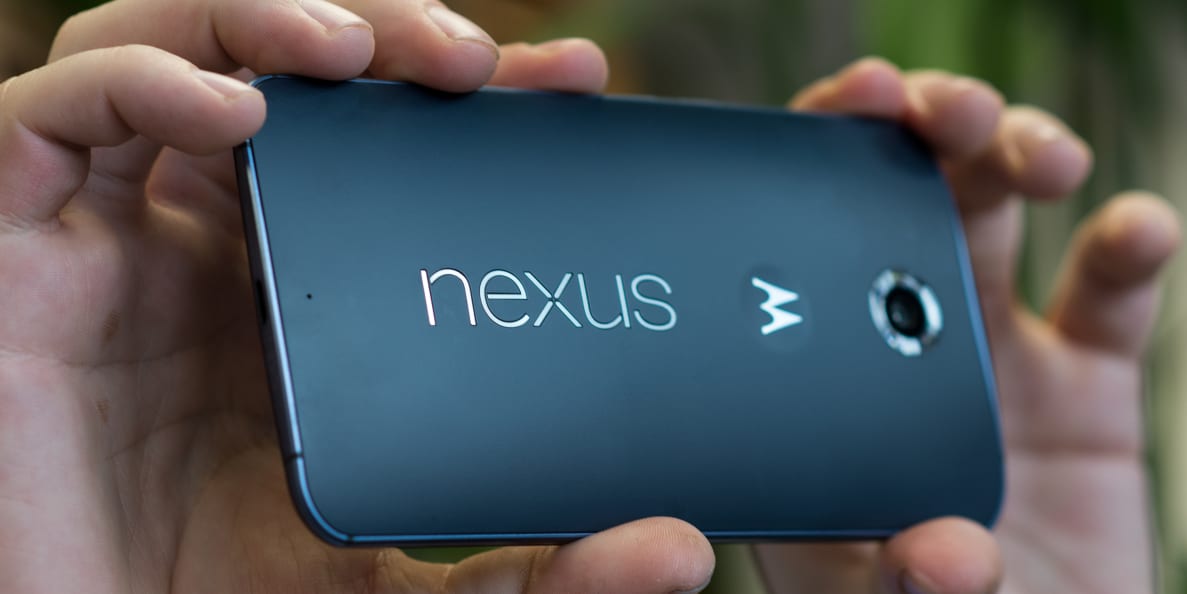For most of its history, the line hasn't wowed with specs. Instead, it preferred to let the price do the talking—most Nexus phones have been priced to move, and with rock-solid hardware backing it up. At least that was the case until the Google Nexus 6 (MSRP $649 unlocked) arrived. This is a phone with hardware fit for the king of Android, while costing a king's ransom, to boot.
Like the fictional character from Blade Runner, the Nexus 6 is nothing short of a radical departure for its manufacturer. Sporting an enormous body known to its developers by the name "Shamu," this is a phone designed for one thing: to make a big splash.
Design
A whale of a phone
Given that this phone marks a stark departure from the original Nexus strategy, it's no surprise that the spec sheet has a lot to dig into. Inside and out, the Nexus 6 is huge: a 5.96-inch 1440 x 2560 OLED display is backed up by a Snapdragon 805 processor and 3GB of RAM, on par with the best smartphones around.
{{ photo_gallery "tour" }}
While the insides are nice, it's the sheer size of the Nexus 6 that defines it. In many ways this blows right past "phablet" and into miniature tablet territory. It's designed to be used with two hands, and works best in landscape orientation. Barring mitts that could easily palm a basketball, most people won't be able to comfortably grip what disgruntled Android fans call the "whalephone" with just a single hand. It makes the Samsung Galaxy Note 4 feel secure by comparison.
Build quality is superb, and the form of the device is surprisingly good. There's very little about the outward appearance that's flashy, maintaining the Nexus line's typically demure appearance. Gone is the soft-touch backing of the Nexus 5, however, with a slicker backing this time around. If you get a case, you'll make the phone even bulkier than it should be, but if you leave it naked, you may have to worry about the dropsies. Definitely get a tempered glass screen protector, at any rate.
A microUSB port on the bottom serves as the Nexus 6's primary charging method, though it can replenish its battery via wireless charging on the Qi standard. However, you're going to love the included Motorola Turbo Charger. Even though the Nexus 6 sports a monster 3,220mAh power cell, overnight charging isn't necessary anymore. You can reliably get a charge that'll last you several hours through only minutes of being chained to an outlet.
As Motorola was the manufacturing partner for the Nexus 6, many of the hardware features found on the smaller Moto X (2014) are carried over. There's a water-resistant nano-coating on much of the internal components (making it dust and splash-resistant), and the proximity sensors also make their return. Active notifications are a little less pretty on the Nexus 6, but it's otherwise a like-for-like copy.
The Nexus line of phones is generally used to showcase the latest versions of Android. KitKat debuted on the Nexus 5, Ice Cream Sandwich on the Galaxy Nexus, and so on. This time, Android 5.0 debuted on the Nexus 6—a complete overhaul of the Linux-based mobile OS. Android is even leaner than before, with several new features such as a battery saver mode that can cut down on performance to extend the last 15% of your battery's capacity.
In Use
Pure Android
Using the Nexus 6 is a treat. Not only does it sport the latest version of Android (Lollipop), but it also has the muscle to make all the features hidden within sing. Compared to past Nexus devices, this iteration feels more like a flagship device as it has a lot more creature comforts enabled from the first time you turn the device on. Many of the halo features of other phones are simply just a part of the experience now, and you don't have to hunt for janky apps to replace functions you like from other phones.
It's also an encouraging sign that the base storage option has ballooned from 16 to 32 gigabytes, with the upgrade option for 64 gigabytes for a measly $50 more. That's a much more accessible upgrade path than that of the iPhone 6 and iPhone 6 Plus, both of which start at 16GB of storage, and require an extra $100 to grab the next model up.
I will say that one of the less-often talked about advantages of the Nexus 6 over its other huge competitors is the voice controls. Not only are they more fleshed-out in Android 5, but Google's voice recognition and parsing software remains the best in the biz. On a lark I decided to switch up languages (Mandarin, Russian, Spanish), accents, and used archaic words in my texts and searches; Google got it right about 90% of the time. That's a hit rate that Siri couldn't touch on a good day. Voice control is fantastic, and especially useful for times when your hands are occupied. All you have to shout is "Ok Google," and then command from there—even when the screen is off.
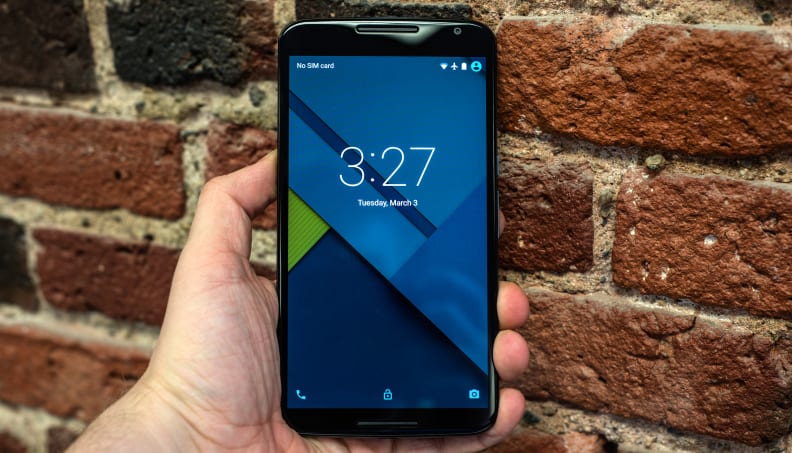
It's not hard to see why this model's codename was "Shamu."
One of the nicest additions to stock Android is improved system controls right in the notification shade. For example, if you use the flashlight or hotspot feature a lot, it will show up in your notification shade as a quick toggle. It's accessible even when the phone is locked, letting you make basic adjustments much quicker.
For media, there are few smartphones better for watching movies. Though the device is unwieldy, it does offer something that the iPhones of the world can't: a comparatively huge OLED screen. It's beautiful, battery efficient, and much better-performing than an LCD. Though the technology is still a little green, it's getting better rapidly.
Where typical OLED screens in phones don't get much brighter than 300 cd/m2 , the display of the Nexus 6 clears 410 cd/m2— more than enough to be seen well in direct sunlight. Fingerprints are still an issue, but when the front face of the screen is clear, total light reflected is cut to somewhere between 3.5% (direct) and 5.5% (all directions). That's laudable for any phone, and among the best we've tested.
Performance
No faustian bargains here
This is the first phone I've tested in 2015 that feels free of major tradeoffs. Say what you want about the size of the phone, but this is a flagship phone through and through. Though there are a raft of high-performance phones coming out in the next few months, the Nexus 6 is setting a high bar.
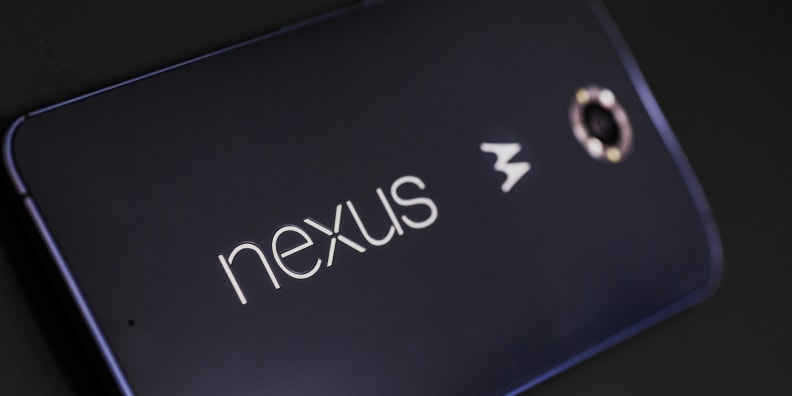
Unlike previous Nexus phones, the 6 is undoubtedly a premium product.
In a word, battery life is stellar. In our punishing web rundown test, it was able to hang tough with the best of them, lasting 6 hours and 27 minutes before giving up the ghost. In real-world terms you're looking at well over a whole day's worth of juice on a single charge, with Android's new battery saver functions pushing it even further.
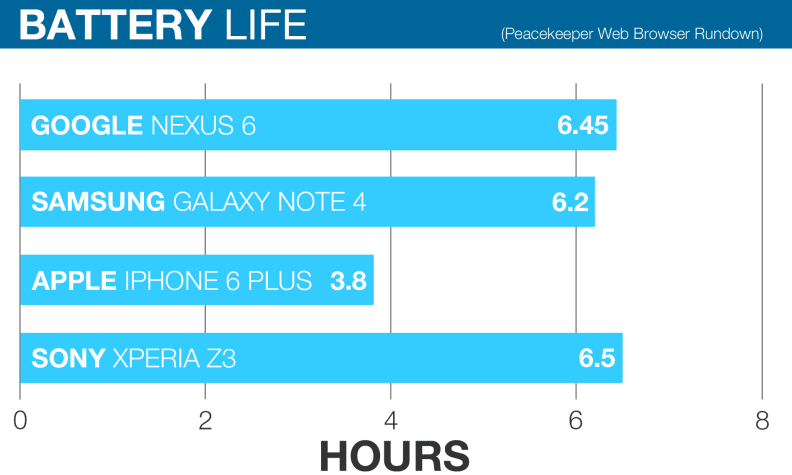
The Nexus 6 has a bit more juice than its cinematic namesake. (NB: Run on Android 5.0.1)
Screen performance is also top-notch. While OLED-bearing smartphones are consistently kicking the butts of LCD-using mobiles, usually the only sore spot is peak brightness, which the Nexus 6 has no issue with. If you really want to pick nits, color performance is closer to the DCI-P3 standard than it is traditional sRGB, but all that means for the user is that their visual content will really pop off the screen's vibrant display. The display doesn't really hit exacting saturation accuracy, but that's a minor concern at worst.
Black and white performance is rock solid, with only the minor hiccup or two. A black level of 0.003 cd/m2 in the face of a peak brightness of 415.26 cd/m2 means the screen has a measured contrast ratio of 138,420:1. That contrast ratio is ultra-wide, giving photos and videos the richness they deserve.
One issue we ran into is that if you use a lock screen, password, or other form of passkey, the phone defaults to using a feature called Full Disk Encryption, and it clips disk read/write speeds quite a bit. Honestly, you'll only notice it when you go looking for performance hiccups, but if you feel like your phone is sluggish, it might not be you.
If you forgo this level of security, you'll find that this phone screams. Even though the Nexus 6 shares the same processor as the Samsung Galaxy Note 4, it beats Samsung's phablet in all of our benchmarks—especially when it comes to graphics. This is the phone you want if you're an avid gamer, without question. The only other phones on the market that gives it a run for its money is the Apple iPhone 6 Plus in AnTuTu, and the LG G Flex 2—when it's not throttled, that is. If you're looking for a relatively futureproof phone, this is your best bet for early 2015.
Editor's note: After testing, Google released Android 5.1 to the public. Early signs are that the redraw/cache hiccups in Lollipop 5.0.1 are gone, as well as the ability to turn off FDE. New units shipped from Google should have this update installed if you order after 3/11/2015
Camera
It's not the size of the sensor that counts...
I'll be honest, after seeing the same Sony-made 1/3.06-inch, 13 megapixel sensor over and over again, I wasn't hopeful for the camera performance on the Nexus 6. However, Google sunk a lot of time into the Lollipop camera API, and I'm suitably impressed—and that's from a guy who lab tests cameras. While low light is still a major issue, the back-end processing is significantly improved, yielding better photos in bright light.

The Nexus 6's noise reduction algorithm destroys fine detail in stills when the lights go down.
Color, sharpness, and image processing are all handled famously, with the camera only bested by higher-resolution sensors in the Sony Xperia Z3 and the Samsung Galaxy Note 4.
The most impressive result was the Nexus 6's color accuracy. In the exact same tests we subject our cameras to, the Nexus 6 posted an average ∆C00 error of 1.93, with an overall saturation of 111.8%. Perceptually anything under 2.2 is basically perfect, with white balance good enough that you'll rarely notice a problem.
Sharpness, too, is quite good. After accounting for the camera unit's 9.15% oversharpening, you can reliably expect results in bright light of about 2,080 line widths per picture height (LW/PH) at MTF50. While there is a bit of falloff in corner sharpness, anything over 1,600 LW/PH is solid. To put this in perspective, that handily beats images from entry-level point and shoots like the Canon PowerShot ELPH 340 HS and the Olympus TG-850.
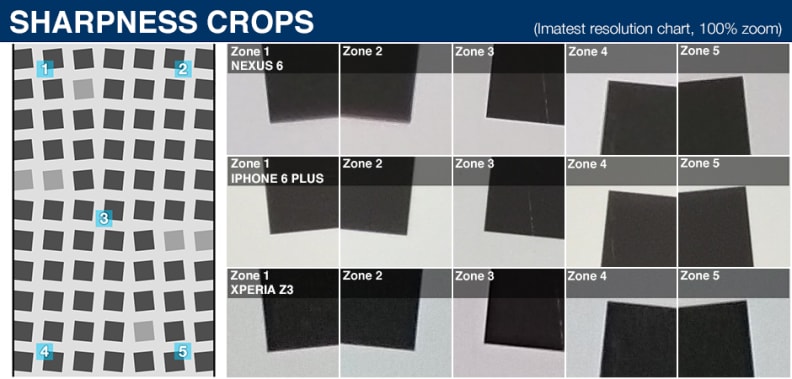
Google's Nexus 6 doesn't lean on oversharpening like other phones— making minor coma, corner sharpness issues more apparent to pixel peepers.
To put icing on the cake, video is also a strong suit for the Nexus 6's camera unit. Using the native 4K shooting resolution, the Nexus was able to resolve 1,275 line pairs per picture height (LP/PH), much sharper than you'll get with phones limited to 1080p shooting. Motion is a bit hit or miss, though, as high frequency patterns like brick can look wonky.
Of course, the party comes to a crashing halt in—where else?—low light. You can't beat physics, and a tiny sensor just can't keep up when the lights go down. It's a problem found on just about every smartphone camera. To make matters worse, the Nexus 6 by default employs an overaggressive noise reduction algorithm that smooths out noise and fine detail, resulting in ugly smearing that harms image quality.
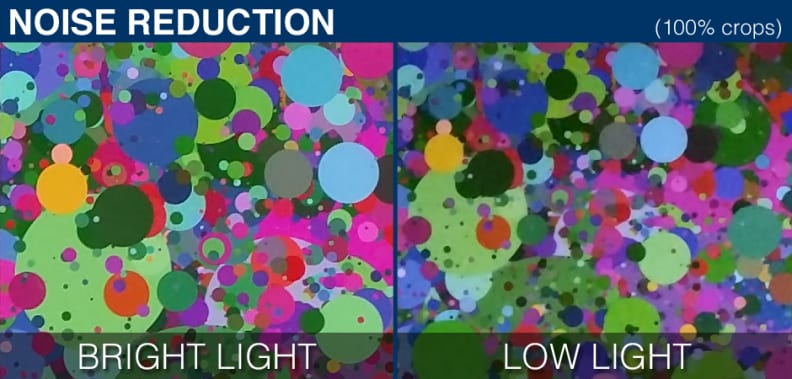
Fine detail gets lost in the shuffle when you shoot in low light.
Basically, in most situations you'll be fine, but as soon as you start trying to take photos at night, during a birthday party, or out on the town after dark, you're going to run into trouble. Android 5 lays the groundwork for smartphone cameras to take a big leap forward, but the Nexus 6 is only a half-step forward.
{{ photo_gallery "sample-photos" }}
Conclusion
Android's leviathan is a whale of a phone
If you're looking for the phone that you can pick up, right now, and be happy with for a long time then the Nexus 6 is a great choice. Only the Galaxy Note 4 contends with the Nexus 6's combination of size and performance, but the Note 4 is more expensive off-contract and is still stuck with Android 4.4.
While smartphones are a fast-moving category, as it sits the Nexus 6 is tough to beat thanks to superb battery life, a reliable camera, and one of the best processors around. The 2015 flagship phones from HTC, Samsung, and LG will surely shift the landscape, but the Nexus 6 should be able to keep pace.

Apps like VSCO Cam give you the option of a filmic look in your snaps.
As with any device on the market, it still has its drawbacks. First and foremost, the Nexus is enormous for a phone you'll carry everywhere. It's less comfortable to hold in one hand than the Note 4, and many people will simply find it impossibly large. You'll adapt given enough time with the phone, but you might drop it before that happens.
But if you're definitely in the market for a phablet, the Nexus 6 is about as good as it gets. The Apple iPhone 6 Plus is powerful, but it can't hold a candle to the Nexus' battery life. The Samsung Galaxy Note 4 is a little easier to hold onto, has a removable battery, expandable storage, and has a stylus, but it's still running Android 4.4 and you may not like Samsung's heavy-handed TouchWiz skin.
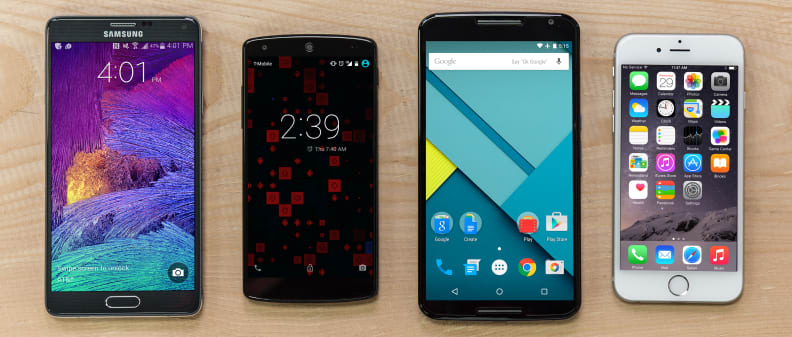
The Nexus 6 is much bigger than the Galaxy Note 4, Nexus 5, and iPhone 6.
If you find the Nexus 6 is simply too large, we'd recommend checking out the 2014 Moto X and Apple iPhone 6, but for sheer performance they don't match up to the larger phones out right now.
Phablets might not be for everyone, but if you're in the market for one, for the time being there's no better choice than the Nexus 6.
Meet the tester
A seasoned writer and professional photographer, Chris reviews cameras, headphones, smartphones, laptops, and lenses. Educated in Political Science and Linguistics, Chris can often be found building a robot army, snowboarding, or getting ink.
Checking our work.
Our team is here for one purpose: to help you buy the best stuff and love what you own. Our writers, editors, and lab technicians obsess over the products we cover to make sure you're confident and satisfied. Have a different opinion about something we recommend? Email us and we'll compare notes.
Shoot us an email

